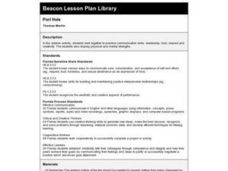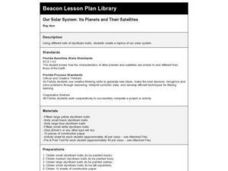Curated OER
Recycling Relay
Learners improve their locomotor skills and their knowledge of recycling. They participate in a relay as they recycle different objects into their proper containers.
Curated OER
Oscar's Garbage Can
Students throw and catch various objects in this introductory activity. They attempt to throw balls into Oscar's Garbage Can.
Curated OER
Port Hole
Third graders work together to lift and pass each other through a tire. They simulate time travel and decide on an object they would take with them through the time portal. They reflect on their experiences and consider the importance of...
Curated OER
Our Solar System: Its Planets and Their Satellites
Fourth graders create a replica of our solar system. Each group arranges the balls in the proper order for our solar system by gluing them to the construction paper. Under each of the balls, the name of the object should be clearly printed.
Curated OER
Alphabet, Vegetable, and Chicken Noodle Parachute Soup
Students throw in their letter or vegetable when the said object or letter is said by the teacher. They also explore how to make a parachute ripple and make waves.
Curated OER
Tape Toes & Rubberband Hands
Young scholars learn the proper form for throwing. Correct hand placement is demonstrated as imaginary and then real objects are thrown at a target. Tape is placed on one shoe and referred to as the tape toe to get the student in...
Curated OER
Cloud Shadows
Young scholars classify clouds as transparent, translucent or opaque. They conduct an experiment to determine the visual opacity of several classroom objects and then conduct further observations of clouds.
Curated OER
One-Difference Classification Train
Students practice their classification skills through hands-on practice. Working in groups, students identify various ways in which similar items can be classified. Given a kit of similar items, students classify objects in multiples...
Curated OER
Ready SET go!
Students practice writing numerals and finding their values. In this numeral practice instructional activity, students write numerals in sequence and draw objects to show the value of the numeral. Students use digital cameras to create a...
Curated OER
Literature is Alive and Everywhere
Students discuss things that are valuable and things that are beautiful. In this ode lesson, students look for something beautiful that inspires them and take a picture of it. Students write an ode to one of the beautiful objects...
Curated OER
Parabolas in Flight
Students utilize a trajectory formula in order to discover the physics of a thrown ball. In this physics lesson, students videotape the trajectory of a thrown ball or basketball shot and analyze the action by breaking the video...
Curated OER
Upholding Community Values Leadership, Government and Kings
Students analyze political systems of African cultures. In this political systems lesson, students compare and contrast the political systems of African cultures by studying objects of art for the values of the governments. Students...
Curated OER
Jungle Gym Drop
Students drop a variety of objects from a jungle gym to explore how different shapes, sizes, and masses relate to forces and motion.
Curated OER
Symmetry: Theory, Reality and Art!
Students explore the concept of geometric symmetry. In this geometric symmetry lesson, students walk around their school and take pictures of objects that demonstrate symmetry. Students use Microsoft Paint to draw the lines of symmetry...
Curated OER
Describing the Motion of a Battery Powered Car
Middle schoolers calculate average velocity of a moving car. In this physics lesson, students construct graphs from data collected in the experiment. They design their own experiment to determine velocity of another moving object.
Curated OER
Physics on the Playground
Second graders explain how friction affects the motion of moving objects. In this physics lesson, 2nd graders investigate how different materials move down the slide. They share their observations with each other.
Curated OER
The Three Rock Groups
Firts graders distinguish between sedimentary, igneous, and metamorphic rocks. They group the rocks into the appropriate group. This is one of the best-organized plans I've seen! Learners watch a PowerPoint presentation which is embedded...
Curated OER
Bartering, an Early Form of Interdependence
Students explore the the benefits and problems associated with a barter system in the Colonies and trace its relationship to the development of interdependence that this system creates. An experience of bartering is created in this...
Curated OER
Carnival of the Animals and Aquarium and Magic Fish
Engage little learners in this moderately developed three-lesson unit on the composer Camille Saint-Saens and his piece "The Carnival of Animals." Each lesson includes a listening, discussion, and an art project to engage your class in...
Curated OER
Time Capsule Essay
Discuss your class' vision of the future. Learners create materials for use in a time capsule. They write letters to explain their contribution and provide photos. Afterwards, they use higher-level thinking skills to reflect on why...
Curated OER
Tea for Two
Pupils examine how certain items can link family and friends together in unique and interesting ways. They analyze how historic artifacts have helped people connect in the past by focusing on a silver teapot used by a family in the...
Curated OER
Dichotomous Key
Students develop an understanding of how a dichotomous key is organized. In this dichotomous activity, student are put into small groups, and work together dividing their group of similar objects (buttons, paper clips, screws, keys...)...
Curated OER
Making Waves, Making Music, Making Noise
Sixth graders watch a demonstration on how talking cans produce sounds. In groups, they compare and contrast the sounds from different sized cans. They participate in a variety of activities to discover how sounds are made and how...
Curated OER
Cursive Handwriting Q
In this cursive handwriting worksheet, students practice writing cursive letters for both the upper and lowercase letter Qq. Students then draw an object that begins with a q and label the drawing using cursive handwriting.























